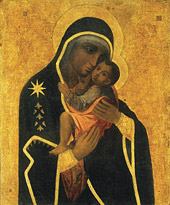Image of Mary and Jesus
The image of Mary and the Child Jesus at the main altar in the Basilica of the Visitation of the Blessed Virgin Mary has long been famed for extraordinary graces. It is said that the Dominican Petras Pugačevskis brought the painting home from Rome, where it was already considered miraculous. The image may have been painted for a monastery in Rome at the start of the 17th century. It reached Samogitian Calvary in the first half of the 17th century, probably in the late 1730s. The style of the painting fits the iconographic type Glykophilousa.
As soon as the miraculous image arrived at Samogitian Calvary, devotional practices related to it began to form, and to blend with other pious customs linked to the Way of the Cross, whose fame was already spreading, and the relic of the Holy Cross brought here from Lublin in 1649. The painting of Mary and the Child was already very widely known by the 18th century. In the second half of the 18th century, and throughout the 19th century, numerous engravings and holy cards of the image were made, further boosting its renown. Some hymns to Our Lady of Samogitian Calvary, written by the Dominican friars, are still known today. But it was the shrine’s annual great feast that most spread devotion to the painting. The Marian Fathers, who arrived here in 1927, also did much to spread devotion to the miraculous image. In fact, even during the repressions of the Soviet era, devotion to Our Lady remained vibrant at Samogitian Calvary.
A book, which had been used since the second half of the 17th century to record miraculous occurrences attributed to the painting, unfortunately was destroyed in a fire in 1896. Votive offerings remain, however, as testimonies to the extraordinary graces that people have received over the centuries. The number of such offerings has grown considerably since the period between the two world wars. In 2006, crowns blessed by Pope Benedict XVI were solemnly place on the painting and the image of Mary was granted the title Queen of Christian Families.








